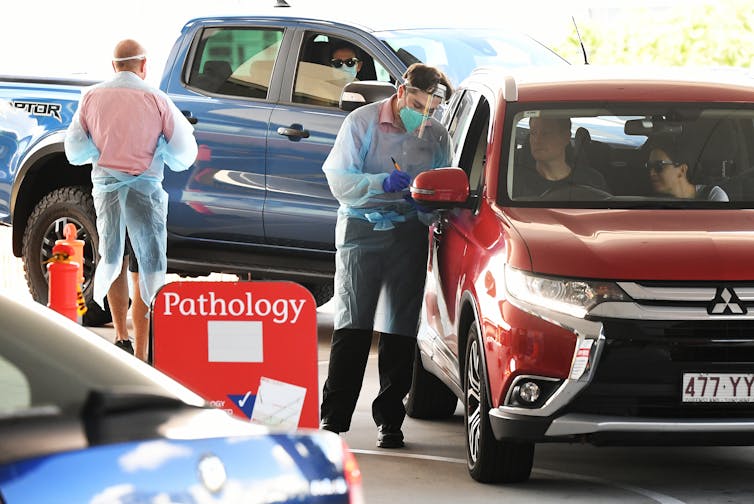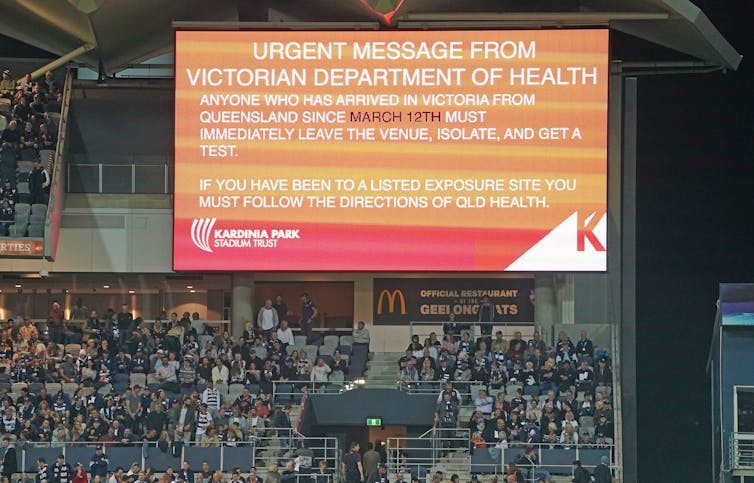COVID in Brisbane: 3-day lockdown begins as authorities scramble to find missing links
- Written by Catherine Bennett, Chair in Epidemiology, Deakin University
Greater Brisbane enters a three-day lockdown from 5pm today after it recorded four additional COVID cases in the community, taking the total number to seven.
Other Australian states and territories have introduced varying levels of restrictions for people who have been in the affected areas.
Since we heard of the initial positive case on Friday, the way things have played out has been a little shambolic.
It’s a pity we’ve got to a point where we need another lockdown in Australia, but it’s imperative Queensland health authorities use this time to connect all the dots in this outbreak. While genomic sequencing can tell us several of these cases are linked, how they’re linked remains something of a mystery.
Here we go again
To recap, we learned on Friday a 26-year-old man from the Brisbane suburb of Stafford had tested positive to COVID-19. He was infected with the B.1.1.7 variant, which originated in the United Kingdom.
The Queensland health department said genomic sequencing confirmed this case was linked to a case earlier this month — a doctor at Brisbane’s Princess Alexandra Hospital who tested positive on March 12 after treating a COVID-positive returned traveller a few days earlier.
We hoped we’d escaped an outbreak as a result of that case, but this shows you can never be too vigilant when it comes to COVID-19. The genomic linkage tells us at least one case slipped through the contact-tracing net.
The 26-year-old reportedly developed symptoms last Monday (March 22), but only sought a test on Thursday (March 25).
Given what we know about the infectious period of the virus, health authorities deemed he could have been infectious a couple of days before that. They’ve released exposure sites from March 20 onwards.
But although we’re told he’s linked to the hospital case, we don’t know exactly how. It’s important we have this information to identify others who may be at risk.
The time it takes to develop symptoms after exposure (the incubation period) is usually around five to six days. The time lapsed between the hospital case (who was exposed on March 9) and this one (likely exposed on March 16 or 17) suggests there may be one or more missing links.
 Queensland health authorities are yet to determine precisely how the 26-year-old man from Stafford came to be infected with the B.1.1.7 strain of coronavirus.
Dave Hunt/AAP
Queensland health authorities are yet to determine precisely how the 26-year-old man from Stafford came to be infected with the B.1.1.7 strain of coronavirus.
Dave Hunt/AAP
After this man tested positive, health authorities rightly tested his close contacts — not only with PCR testing to identify current infections, but with serology testing. This picks up antibodies against SARS-CoV-2, the virus that causes COVID-19, to indicate if someone has recovered from the virus. We call this an upstream search. The man’s brother returned a positive serological result.
Could this brother be the missing link? Reports suggest authorities believe he is — but there’s a vagueness about the nature of the link, and also about where the brother had been while he was infectious.
It’s helpful to have the genomic link back to the Princess Alexandra Hospital incident so we know where to look to unpack the full outbreak picture. But genomics alone don’t tell us whether the brother was a direct exposure — for example, whether he visited the hospital at that time or had some other connection with the doctor who was infected — or whether there are more intermediary cases to be found.
Although he’s now recovered, it’s still important we ascertain precisely where he got the virus, and his movements while he was potentially infectious. If we can’t link him to the hospital in any way beyond the genomic test results, we’re still essentially looking at a mystery case.
Read more: How the latest COVID cases slipped through in NSW and Queensland — and what we can do better
The second case reported on Saturday, a 20-year-old man from Strathpine in the Moreton Bay region north of Brisbane, is also a direct contact of the 26-year-old man. He is currently COVID-positive and could have been infected at the same time.
Today we had two more cases linked to that cluster: work colleagues of the Strathpine case.
And importantly, we now have two other community cases that have not at this stage been epidemiologically linked to this cluster — a nurse who has worked on the COVID ward at the Princess Alexandra Hospital, and her sister.
The health department is waiting on genomics to confirm they are “linked”. But it’s essential we understand the epidemiological connection, not just the genomic similarity of strains.
So what now?
In addition to the fact the chains of transmission haven’t been mapped out clearly, we’ve also seen some mixed messages over recent days.
Reports the Strathpine man held a house party while waiting for his test results were later retracted. Little things like this mean there’s an element of confusion at a time when it’s essential public messaging is clear.
 People who had travelled from Queensland since March 12 were instructed to leave an AFL match in Victoria on Friday night to get tested and isolate.
Scott Barbour/AAP
People who had travelled from Queensland since March 12 were instructed to leave an AFL match in Victoria on Friday night to get tested and isolate.
Scott Barbour/AAP
These “circuit-breaker” lockdowns have been positioned as a safety net allowing contact tracers to get on top of cases before they become larger outbreaks. They must be implemented quickly to work, and we now wait and see whether this one has been imposed quickly enough.
I believe health authorities will be able to bring this outbreak under control in the coming days. But we also need to ask the question: how did it come to this?
The fact we’re contending with this latest cluster at all indicates the follow-up after the hospital case earlier this month wasn’t sufficient; an outbreak was insidiously unfolding under the radar. At least one person who was exposed was able to fall through the cracks. This is an issue Queensland health authorities will need to review, and other states and territories can learn from.
Authors: Catherine Bennett, Chair in Epidemiology, Deakin University





